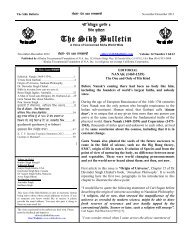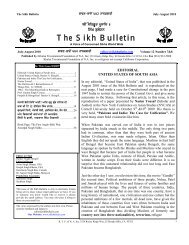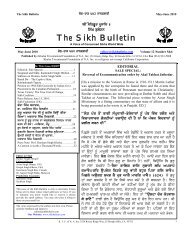Selected Editorials - The Sikh Bulletin
Selected Editorials - The Sikh Bulletin
Selected Editorials - The Sikh Bulletin
You also want an ePaper? Increase the reach of your titles
YUMPU automatically turns print PDFs into web optimized ePapers that Google loves.
years. Nor are we concerned about Hindu sensitivities while discussing those hymns in Guru Granth<br />
Sahib that are critical of Hindu practices. We cannot wish the problems to go away. We have to face them<br />
squarely. This editorial is invariably tied to the previous month’s editorial ‘Bani and Bana’ and should be<br />
read in that context.<br />
<strong>The</strong> Encyclopaedia of <strong>Sikh</strong>ism published by <strong>The</strong> Punjabi University, Patiala defines <strong>Sikh</strong>, Singh and<br />
Khalsa 2 . If we could dispassionately accept these definitions we will be on the road to ‘charhdi kala’.<br />
<strong>The</strong>re really is no other choice.<br />
SIKH:<br />
To quote from <strong>The</strong> Encyclopaedia, “<strong>The</strong> word <strong>Sikh</strong> goes back to Sanskrit sisya, meaning a learner or<br />
disciple. In Pali, sisya became sissa. <strong>The</strong> Pali word sekha (also sekkha) means a pupil or one under<br />
training in a religious doctrine (sikkha, siksa). <strong>The</strong> Punjabi form of the word was <strong>Sikh</strong>.”<br />
With the passage of time common noun sikh became proper noun <strong>Sikh</strong> used exclusively for the followers<br />
of Guiru Nanak. In this definition there is no reference to a person’s appearance. To quote from the<br />
previous month’s editorial, “Let us take ourselves to the time of Guru Nanak. Guru is giving a sermon.<br />
Who is he giving the sermon to In his audience are Hindus and Muslims, adherents of the two dominant<br />
faiths of that time. Did he treat them differently from each other or did he treat them as humans eager to<br />
make sense out of this life Did he see Hindu and Muslim faces or Human faces” He was, clearly,<br />
addressing his <strong>Sikh</strong>s. Bhatti Sardar Rai Bular and Mardana were among his <strong>Sikh</strong>s as were, later, Bhai<br />
Nand Lal, Bhai Kanhaiya, Kaura Mall, Des Raj, Dina Nath and Bhai Vasti Ram. 3<br />
As time went on changes took place. Children born into <strong>Sikh</strong> families were automatically considered as<br />
<strong>Sikh</strong>s without any formal initiation rite. One may consider that as their birth right. Among some Hindu<br />
families the eldest son was raised as a kesadhari <strong>Sikh</strong> while the rest of the family with cut hair came to be<br />
called sahajdhari. That word for a cleanshaven <strong>Sikh</strong> is inappropriate. <strong>The</strong> Encyclopaedia of <strong>Sikh</strong>ism<br />
defines ‘sahaj’ as “…a state of mental and spiritual equipoise without the least intrusion of ego…” Not<br />
many ‘sahajdharis’ would meet that criteria. More appropriate term, as opposed to kesadhari, would be<br />
non-kesadhari (mona). A person converting from one faith to another obviously has to undergo some<br />
initiation rite. So far that rite is ‘Khande di Pahul’.<br />
SINGH:<br />
To quote from <strong>The</strong> Encyclopaedia of <strong>Sikh</strong>ism, “Singh, from Sanskrit sinha for lion, is an essential<br />
component of the name for a <strong>Sikh</strong> male. Every <strong>Sikh</strong> male name must end with 'Singh'. Historically, this<br />
was so ordained by Guru Gobind Singh on the Baisakhi day, 30 March 1699, when he inaugurated the<br />
Khalsa, <strong>The</strong>y were to adopt the five prescribed emblems, including kesa or unshorn hair and share a<br />
common end-name 'Singh' in token of having joined the self-abnegating, martial and casteless fellowship<br />
of the Khalsa…While '<strong>Sikh</strong>' is a spiritual appellation, 'Singh' has socio-political overtones in addition.”<br />
Historically the word Singh is not unique to the <strong>Sikh</strong>s. It predates the Guru period. India’s current<br />
Foreign Minister, Natwar Singh, is not a <strong>Sikh</strong>. Thus all Singhs are not <strong>Sikh</strong>s. <strong>The</strong> dilemma is should all<br />
<strong>Sikh</strong>s be Singhs Dr. Harbans Lal is a <strong>Sikh</strong>, just as Bhai Nand Lal was a <strong>Sikh</strong>. Dr. Harbans Lal’s <strong>Sikh</strong><br />
credentials are accepted by the <strong>Sikh</strong> establishment in India and abroad, including the so called ‘Jathedars’,<br />
SGPC, <strong>Sikh</strong> faculty of Universities in Panjab, Institute of <strong>Sikh</strong> Studies, Chandigarh, <strong>Sikh</strong> Review,<br />
Calcutta and Dr. Chahal’s Institute for Understanding <strong>Sikh</strong>ism, Laval. He even held the position of<br />
President of All India <strong>Sikh</strong> Student Federation during his student days in Panjab. He participates and<br />
leads in various national and international <strong>Sikh</strong> gatherings. Similarly, Alice Basarke in Canada and<br />
Claudia Martins in Brazil consider themselves <strong>Sikh</strong>s and I do accept all of them as such.<br />
KHALSA:<br />
23
















